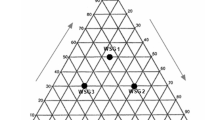Abstract
CaCO3 powder containing C-14, which has a long half-life, is generated from the treatment process of spent activated carbons from the air cleaning system in a nuclear facility, can be decomposed into CaO and CO2 gas at a temperature above 600 °C. This CaCO3 must be fabricated into a stable waste form for final disposal at a temperature below 600 °C. In this study, tests on the solidification of CaCO3 into a waste form were conducted using a bismuth oxide glass with a low melting point. The CaCO3 was solidified into a homogeneous glass–ceramic waste form with a waste loading of 40 wt% at 460 °C without CaCO3 decomposition. This waste form had high values of density (3.15 g/cm3) and compressive strength (42.09 MPa), and it was confirmed through leaching tests (ANS 16.1, PCT) that the waste form also had a high chemical durability.











Similar content being viewed by others
References
So J, Cho H (2017) Thermal characteristics of spent activated carbon generated from air cleaning units in Korean nuclear power plants. Nucl Eng Technol 49:873–880
Eun H, Yang H, Kim H, Kim S, Lee K, Seo B (2021) A study on immobilization of 14CO2 using inorganic materials. J Radioanal Nucl Chem 328:627–635
Song K, Park G, Cho K, Lee Y, Choi K, Kim H, Chung K, Kim K, Kim I, Chung J (2008) Development of the process for decontaminating 14C & 3H in the waste activated carbon from air cleaning system. KAERI, KAERI/CR-316/2008
Montes-Hernandez G, Pérez-López R, Renard F, Nieto JM, Charlet L (2009) Mineral sequestration of CO2 by aqueous carbonation of coal combustion fly ash. J Hazard Mater 161:1347–1354
Murakami FS, Rodrigues PO, de Campos CMT, Silva MAS (2007) Physicochemical study of CaCO3 from egg shells. Food Sci Technol 27(3):658–662
Li X, Iv Y, Ma B, Jian S (2017) Decomposition kinetic characteristics of calcium carbonate containing organic acids by TGA. Arab J Chem 10:S2534–S2538
Cheeseman CR, Asavapisit S, Knight J (1998) Effect of uniaxially pressing ordinary Portland cement pastes containing metal hydroxides on porosity, density, and leaching. Cement Conc Res 28(11):1639–1653
Eun H, Chang NO, Kim SB, Seo BK (2021) Feasibility study on immobilization of radioactive cobalt and BaSO4 waste powder using low-temperature sintering. Water Air Soil Pollut 232(333):1–11
Measurement of the leachability of solidified low-level radioactive wastes by a short-term test procedure. ANS 2019 ANSI/ANS-16.1-2019
Standard test methods for determining chemical durability of nuclear hazardous and mixed waste glasses and multiphase glass ceramics: the product consistency tests (PCT). ASTM 2008 C12855-02
Standard test method for compressive strength of cylindrical concrete specimens. ASTM International, West Conshohocken, C39M-18 (2018)
Crum JC, Turo L, Riley B, Tang M, Kossy A (2012) Multi-phase glass-ceramic as a waste form for combined fission products: Alkali, alkaline earths, lanthanides, and transition metals. J Am Ceram Soc 95(4):1297–1303
Chen M, Juuti J, His C, Chia C, Jantunen H (2015) Dielectric properties of ultra-low sintering temperature Al2O3-BBSZ glass composite. J Am Ceram Soc 98(4):1133–1136
Khan H, Yerramilli AS, D’Oliveira A, Alford TL, Boffito DC, Patience GS (2020) Experimental methods in chemical engineering: X-ray diffraction spectroscopy-XRD. Can J Chem Eng 98(6):1255–1266
Ahn J, Kim W, Um W (2019) Development of metakaolin-based geopolymer for solidification of sulfate-rich HyBRID sludge waste. J Nucl Mater 518:247–255
Jantzen CM, Bibler NE, Beam DC, Crawford CL, Picket MA (1993) Westinghouse Savannah River Co. Aiken SC WSRC-TR-92-346
Teng Y, Wang S, Huang Y, Zhang K (2014) Low-temperature reactive hot-pressing of cerium-doped titanate composite ceramics and their aqueous stability. J Eur Ceram Soc 34:985–990
Vienna JD, Crum JV (2018) Non-linear effects of alumina concentration on Product Consistency Test response of waste glasses. J Nucl Mater 511:396–405
Mattigod SV, Lindberg MJ, Westsik Jr JH, Parker KE, Chung CW (2011) Waste acceptance testing of secondary waste forms: cast stone. Ceramicrete and DuraLith USDOE PNNL-20632
Sung SH, Jeong EY, Kim KH (2008) Radwaste characteristics and disposal facility waste acceptance criteria. J Nucl Fuel Cycle Technol 6(4):347–356
Acknowledgements
The authors would like to express their appreciation for the support provided by the National Research Foundation of Korea (NRF), which is funded by the Ministry of Science, ICT and Future Planning (MSIP) of the Republic of Korea (NRF- 2017M2A8A5015147).
Author information
Authors and Affiliations
Corresponding author
Ethics declarations
Conflict of interest
The authors declare that they have no conflict of interest.
Additional information
Publisher's Note
Springer Nature remains neutral with regard to jurisdictional claims in published maps and institutional affiliations.
Rights and permissions
Springer Nature or its licensor holds exclusive rights to this article under a publishing agreement with the author(s) or other rightsholder(s); author self-archiving of the accepted manuscript version of this article is solely governed by the terms of such publishing agreement and applicable law.
About this article
Cite this article
Eun, HC., Yang, HC., Kim, HJ. et al. A study on solidification of CaCO3 powder containing C-14 by using a low melting glass material. J Radioanal Nucl Chem 331, 3735–3744 (2022). https://doi.org/10.1007/s10967-022-08393-z
Received:
Accepted:
Published:
Issue Date:
DOI: https://doi.org/10.1007/s10967-022-08393-z




